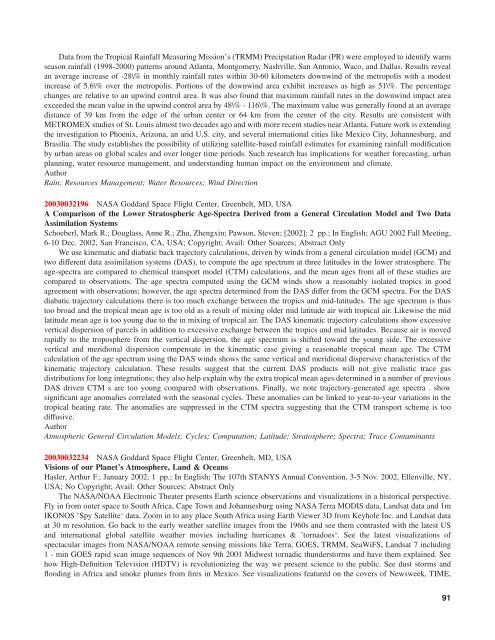You also want an ePaper? Increase the reach of your titles
YUMPU automatically turns print PDFs into web optimized ePapers that Google loves.
Data from the Tropical Rainfall Measuring Mission’s (TRMM) Precipitation Radar (PR) were employed to identify warm<br />
season rainfall (1998-2000) patterns around Atlanta, Montgomery, Nashville, San Antonio, Waco, and Dallas. Results reveal<br />
an average increase of -28\% in monthly rainfall rates within 30-60 kilometers downwind of the metropolis with a modest<br />
increase of 5.6\% over the metropolis. Portions of the downwind area exhibit increases as high as 51\%. The percentage<br />
changes are relative to an upwind control area. It was also found that maximum rainfall rates in the downwind impact area<br />
exceeded the mean value in the upwind control area by 48\% - 116\%. The maximum value was generally found at an average<br />
distance of 39 km from the edge of the urban center or 64 km from the center of the city. Results are consistent with<br />
METROMEX studies of St. Louis almost two decades ago and with more recent studies near Atlanta. Future work is extending<br />
the investigation to Phoenix, Arizona, an arid U.S. city, and several international cities like Mexico City, Johannesburg, and<br />
Brasilia. The study establishes the possibility of utilizing satellite-based rainfall estimates for examining rainfall modification<br />
by urban areas on global scales and over longer time periods. Such research has implications for weather forecasting, urban<br />
planning, water resource management, and understanding human impact on the environment and climate.<br />
Author<br />
Rain; Resources Management; Water Resources; Wind Direction<br />
20030032196 NASA Goddard Space Flight Center, Greenbelt, MD, USA<br />
A Comparison of the Lower Stratospheric Age-Spectra Derived from a General Circulation Model and Two Data<br />
Assimilation Systems<br />
Schoeberl, Mark R.; Douglass, Anne R.; Zhu, Zhengxin; Pawson, Steven; [2002]; 2 pp.; In English; AGU 2002 Fall Meeting,<br />
6-10 Dec. 2002, San Francisco, CA, USA; Copyright; Avail: Other Sources; Abstract Only<br />
We use kinematic and diabatic back trajectory calculations, driven by winds from a general circulation model (GCM) and<br />
two different data assimilation systems (DAS), to compute the age spectrum at three latitudes in the lower stratosphere. The<br />
age-spectra are compared to chemical transport model (CTM) calculations, and the mean ages from all of these studies are<br />
compared to observations. The age spectra computed using the GCM winds show a reasonably isolated tropics in good<br />
agreement with observations; however, the age spectra determined from the DAS differ from the GCM spectra. For the DAS<br />
diabatic trajectory calculations there is too much exchange between the tropics and mid-latitudes. The age spectrum is thus<br />
too broad and the tropical mean age is too old as a result of mixing older mid latitude air with tropical air. Likewise the mid<br />
latitude mean age is too young due to the in mixing of tropical air. The DAS kinematic trajectory calculations show excessive<br />
vertical dispersion of parcels in addition to excessive exchange between the tropics and mid latitudes. Because air is moved<br />
rapidly to the troposphere from the vertical dispersion, the age spectrum is shifted toward the young side. The excessive<br />
vertical and meridional dispersion compensate in the kinematic case giving a reasonable tropical mean age. The CTM<br />
calculation of the age spectrum using the DAS winds shows the same vertical and meridional dispersive characteristics of the<br />
kinematic trajectory calculation. These results suggest that the current DAS products will not give realistic trace gas<br />
distributions for long integrations; they also help explain why the extra tropical mean ages determined in a number of previous<br />
DAS driven CTM s are too young compared with observations. Finally, we note trajectory-generated age spectra . show<br />
significant age anomalies correlated with the seasonal cycles. These anomalies can be linked to year-to-year variations in the<br />
tropical heating rate. The anomalies are suppressed in the CTM spectra suggesting that the CTM transport scheme is too<br />
diffusive.<br />
Author<br />
Atmospheric General Circulation Models; Cycles; Computation; Latitude; Stratosphere; Spectra; Trace Contaminants<br />
20030032234 NASA Goddard Space Flight Center, Greenbelt, MD, USA<br />
Visions of our Planet’s Atmosphere, Land & Oceans<br />
Hasler, Arthur F.; January 2002; 1 pp.; In English; The 107th STANYS Annual Convention, 3-5 Nov. 2002, Ellenville, NY,<br />
USA; No Copyright; Avail: Other Sources; Abstract Only<br />
The NASA/NOAA Electronic Theater presents Earth science observations and visualizations in a historical perspective.<br />
Fly in from outer space to South Africa, Cape Town and Johannesburg using NASA Terra MODIS data, Landsat data and 1m<br />
IKONOS ’Spy Satellite‘ data. Zoom in to any place South Africa using Earth Viewer 3D from Keyhole Inc. and Landsat data<br />
at 30 m resolution. Go back to the early weather satellite images from the 1960s and see them contrasted with the latest US<br />
and international global satellite weather movies including hurricanes & ’tornadoes‘. See the latest visualizations of<br />
spectacular images from NASA/NOAA remote sensing missions like Terra, GOES, TRMM, SeaWiFS, Landsat 7 including<br />
1 - min GOES rapid scan image sequences of Nov 9th 2001 Midwest tornadic thunderstorms and have them explained. See<br />
how High-Definition Television (HDTV) is revolutionizing the way we present science to the public. See dust storms and<br />
flooding in Africa and smoke plumes from fires in Mexico. See visualizations featured on the covers of Newsweek, TIME,<br />
91
















